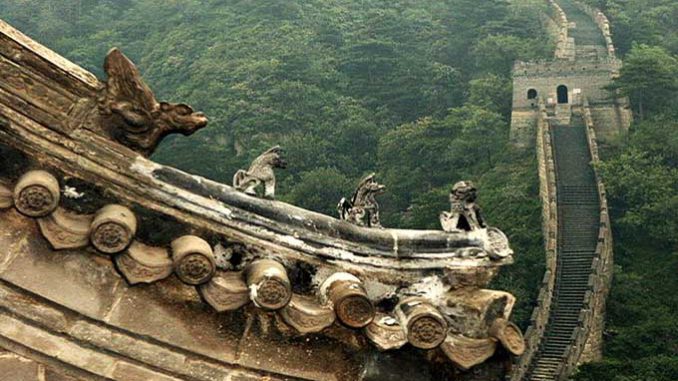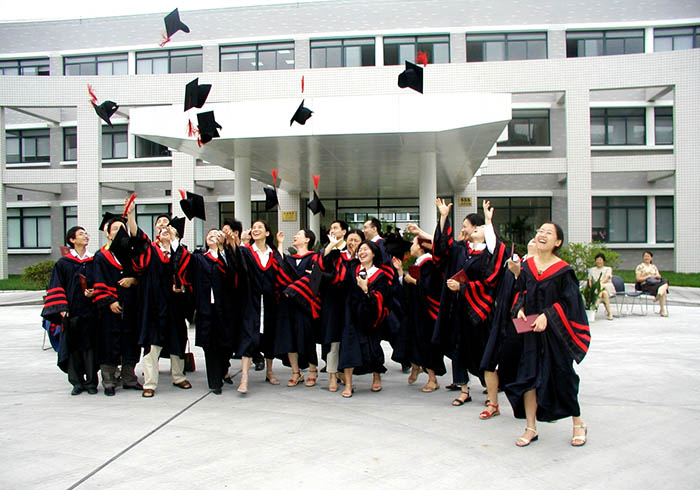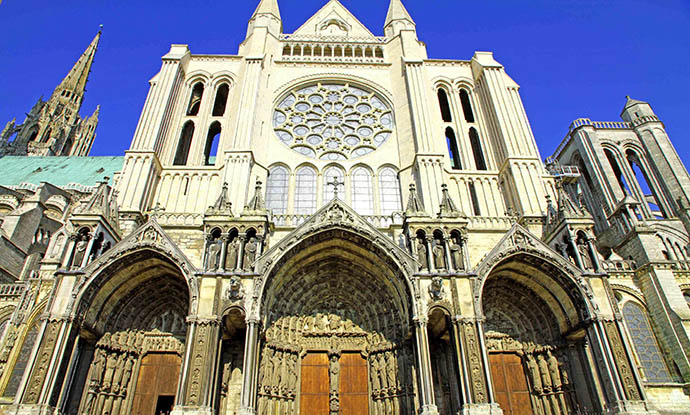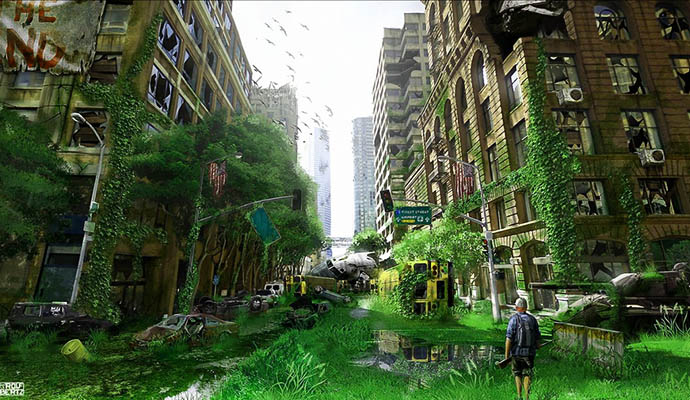
China can brag of the longest continuous line of development of a civilization in the world. In it only India, however, competes with it separate possession of the peninsula of Hindustan merged to one state recently, and China united in the 3rd century BC and since then was almost not separated. And still huge Celestial Empire stretched from Tibet, Tien Shan and the Takla Makan Desert to the Pacific coast and seeming from the outside so ethnically monolithic was never the territory of accommodation only of one nationality – Han, a close formation removing the family tree from a sinantrop to Mao Tse Tung. Someone in China built pyramids. Others for some reason carried the Scottish kilts (skirts). The third laid claim to Liliputians and at the same time read out themselves descendants of newcomers from heaven. The fourth modelled the Universe by means of mercury. All these strange things are united by one: they never were on a look, gaining popularity in many respects only thanks to a case. Whether China hides the ancient treasures – it is free or involuntarily? Let’s try to understand.
Flying over Sian
As well as it is necessary to any ancient civilization respecting itself, Chinese (more true, that numerous that existed in the territory of the present People’s Republic of China) generated huge stone constructions. And the speech not only about the Great wall visible from space, but also about such, apparently, purely Egyptian or Mexican constructions, as pyramids. It now on service of the fan of mysteries of Earth costs an ubiquitous eye of Google Maps and when the American pilot of times of World War II James Gaussman flying from India to China saw from above what called later “A great white pyramid”, he was mind-blowing and intrigued, – especially as on a construction top something shining came in dream to it precious fire. Business happened near the ancient capital city of Siani which is most of all glorified by Terracotta guard of the first emperor combiner of the country Qin Shihuanga (rule 259-220 BC) and its sepulchral hill too ranked as the Chinese pyramids. In due time I had to stand on top of this hill, and pyramidal nowadays it does not look at all. Inside, according to the legend, there is a model of the Universe of that time, with the seas and the rivers made of not evaporating mercury and all this is honestly described by the Chinese “father of history” Sima Qian in the famous work “Shi Ji” (“Historical notes”). Not so long ago archeologists launched in a tomb the probes which confirmed existence in a mercury pyramid so ancient legends did not tell lies. Certainly, there is nothing strange that in Ancient China there were similar structures (see. “As built pyramids” on page 25), however the sensation lifted around them and the secret aura surrounding them always gave them special appeal to journalists, writers and travelers, complicating thereby work of scientists.
Under oppression of pyramids
Because of basic closeness of China for intervention from the outside any finds, especially unintentional, got during casual flights or espionage expeditions somewhere in Tibet, immediately acquire the status of a sensation. The fact that the Chinese pyramidal tombs became property of science very late – result of rather late development of the Chinese archeology: it just did not exist approximately to the middle of last century. While archaeological monuments in China, by modest calculations, about 400 thousand, and 770 of them belong to the protected state, it is possible to imagine a neizvedannost of this subject. So, as if the modern science was skeptical about amateur archeologists with their barbarous methods, but they, having come with Napoleon to Egypt or after Shliman to Turkey, opened for the West of antiquity of these civilizations. And here China (in particular, the Province of Shaanxi where there is a majority of pyramids) is still generally closed for external studying and therefore generates a huge number of conjectures so it is always necessary to divide fascinating cases of detection of unclear objects and their systematic studying. As a result almost century the White pyramid intriguing riddles hunters suddenly appears freely visited museum Maolin-mavzoleem of the emperor Fish (rule 141-87 BC) dynasties Han. In only one Shaanxi 38 considered pyramids – in them lie relatives and confidants of emperors, and governors of dynasties Han, Tang, Sung, the Western Xia and, of course, representatives of earlier cultures in the territory of China built gravestone hills. But how the White pyramid became a museum construction? Just as the country described by Marco Polo “Roll” it was later China. The pilot did not know over what his plane flew by, and what sparkled under the sun at pyramid top, was only a fragment of its facing. When the reforms which brought with themselves big came to China than at James Gaussman, openness to the outside world (and as a result – and tourism), it seemed that during the time which passed since the end of war, archeologists and the museum authorities opened a tomb for visit, even without suspecting that she managed to visit the great hidden mystery of the Median empire. Unlike pyramids of Giza (sometimes in an arrangement of the Chinese pyramids see the same drawing, as in Egypt), Chinese not everyone turned into a tourist sight relatively recently, and. Many still stand among arable or jellied fields, many are set with trees. Whether in the camouflage purposes or because land hunger in Celestial Empire remains so cruel, it is difficult to tell: the severe reality is reflected in a joke that in China even intervals between cross ties are opened.
AS BUILT PYRAMIDS
Present that you need to place something in the earth, say, the tsar’s tomb. The more solemnly burial, the dead was more kingpin during lifetime, the more place is required to it for placement of funeral utensils, sometimes – wives, concubines, service personnel, horses, soldiers and pieces of furniture. The more comfortably you want to arrange a posthumous dwelling of the governor, the more earth should be taken outside. Having placed deceased and all its economy in the funeral cell, you, most likely, will not just fill up over it a surface, and use the received earth to fill from above an effective memorable barrow. Bulk is naturally distributed on a surface in the form of a cone, and those are more and more simple barrows – for example steppe, Scythian. If the civilization moves ahead further, to a barrow, most likely, will give the form, that is will straighten a cone to a pyramid. Options are possible different: the top can be made flat (the Chinese pyramids or pyramids of Teotihuacan in Mexico are that), to add from above one more “step”, then more and more. So we will receive, say, the well-known pyramid of Dzhoser in Egypt, step pyramids of Mesoamerica or the Babylon ziggurats, the best-known of which was Etemenanki’s ziggurat better known as the Babel tower or … a pyramid in China. As shows experience of Egypt, step pyramids, simpler in construction, ideally give way smooth, demanding more perfect technologies.
Tibetan newcomers
One more once fried sensation of the Chinese archeology – the “space disks” from a jasper (other name of this stone – nephrite) found in Tibet. In 1978 somebody David Agamon published the book “Solar Gods in Exile”, referring to notes of the recently deceased Oxford boss, professor Caryl Robin-Evans who told about an expedition of 1947 to Tibet where he traveled around mountains the Bayan Har and came across the mysterious people under the name a track (or the boor). It allegedly occurred from the aliens who were wrecked on Earth what photos of these tiny people, their “king” and “queen” and sacral stone disks with images of planets and extraterrestrial messages confirmed. It turned out that a certain spaceship of newcomers by the name of a track (or a dzopa) was wrecked on the Plateau of Tibet 12 thousand years ago. Local inhabitants with unexpectedly bible name “boor” did not begin to repair to newcomers a plate, and those from could not be done somehow adapted to life on Earth and took in the wife of some boorish women. Meanwhile the pudges boors dissatisfied with such turn of events killed most of newcomers and buried them in caves where in legs of skeletons and the described disks were, allegedly, found. Stones indeed looked intriguingly: planets, orbits and hieroglyphs alternated in them, narrating about the star homeland of the tribe a track. However the sensation which still finally is not dismissed by ufologists by itself came to naught in 17 years after an exit of “Solar gods”: British David Gemon recognized that Agamon wrote the book under a pseudonym, having envied the world popularity of creations of Erich von Deniken about ancient astronauts – “Return to stars” and “Gold of gods”. Article of the 1960th year in the western magazine “Russian Digest” and … the French popular scientific novel “Disks We Beat — Cara” of Daniel Pire was a source for the imagination; Robin-Evans Gemon, certainly, too invented professor Caryl.
Disks with holes
But the most interesting that disks per se – not an invention. In neolytic China jasper disks би were a commonplace, and they are perfectly known to archeologists. The earliest belong to Liangzhu’s culture (3400-2250), late treat the dinastiyny period – Shang, Zhou and Han, turned them and from glass. Bee is a flat jasper disk with a round hole in the middle, in the Stone Age they were not decorated in any way, and here, say, in the period of Zhou (1046-256 BC) – ornamented with a pattern from octahedral notches. Sense of a decor indeed cosmological: the disk stated existence of four directions in space, granted to the owner goodwill of heaven, etc. High quality of artifacts testifies to their exclusive value and, respectively, to the uncommon social status of the owner (disks really put in burials). Bee was symbolized by heaven whereas there were also ritual objects for the earth, Cong – the jasper hollow cylinders ornamented with deepenings. Everything develops: historians know that the cosmological concept би and Cong remained in Ancient China long enough: “the covering sky”, гайтянъ (its model is just би) rotated around the central axis of the world (its model – Cong), need of an opening for a disk and its general similarity with an UFO iconography from here. (би) and “vessels” (Cong) used “covers” shamans of that time – key figures of culture Liangzhu and keepers of real cosmological representations ancient. The head of the won possession gave to Zhou’s era to the winner the disk as a sign of submission, and at burial of the governor disks placed in a tomb on a breast or a stomach deceased, as if connecting it to heaven. The Neolithic – culture unwritten and cannot stand for itself. The only disk a track with hieroglyphic inscriptions called in literature by name the next professor (this time – Polish: Lolladoff plate – Loladof’s plate) which is allegedly found in Nepal and is bought in India wanders from one ufologichesky publication in another. But also it is a vulgar duck of the same Gemon who admitted that a track were the best draw in his life.
The singing mummies from the Takla Makan Desert
In many ancient cultures there was a belief that the body of deceased has to be kept because can be useful to it in life behind a coffin. The most known example – the Egyptian art of mummification to which we have to tell thanks for an opportunity to investigate, say, genetic material of Tutankhamun. But sometimes the nature itself undertakes functions of the person and makes to historians gifts. For example, in the eighties the last century the Chinese archeologists exploring the southern site of a river basin Tarim – the extensive inhospitable desert region on which outer edge once there passed the Great silk way found burials with bodies of people, deceased 3,5-4 millennia ago. The mummified remains were found in the most droughty and salted part of Central Asia – in the Takla Makan Desert of the Chinese Turkestan (Xinjiang Uyghur Autonomous Region of the People’s Republic of China), near the cities of Cher-chen and Loulan. Safety of the found remains surpasses a state even of the Egyptian mummies – and all thanks to exclusively dry air of the region and that fact that graves were dug in the salt soil accelerating process of drying of fabrics and killing microorganisms. So mummification happened 4 thousand years ago absolutely in a random way. The bodies buried in the desert in the winter froze and were dried up before began to decay. Placed them in coffins without the bottom, and free air circulation promoted full drying of remains. The bodies interred in hot season turned into skeletons. To the oldest mummies from Cherchenya about three thousand years, and to elders from Loulani – around four. Dead men were dressed in bright dresses which did not collapse and did not fade for last millennia. Finds placed in the Provincial museum of Urumqi where they reunited with several mummies found in this region. However only in 1994 together with the publication in the Discovery magazine of photos and articles of a mummy of Urumqi became known to the scientific world.
Through Eurasia in the Scotswoman and a Phrygian cap
What special is in cherchensky mummies? First of all all of them are Caucasians not less than 180 cm in height, it is unknown as appeared in these parts. It the “cherchensky man”, three women and the three-months baby lying on a pillow from white sheep wool who is wrapped up in fine brown matter and tied with red and blue cords. The child was buried with “small bottle” from a cow horn and, probably, with the most ancient in the history the pacifier made of a sheep udder; in the face of the child blue stones. The jaw of the man is tied accurately up therefore he looks quite usually, garters on the heads of women weakened, and their persons took a form “singing” or “shouting”. The man is based in a pose of the person who fell asleep in a hammock therefore – taking into account safety of a body – visitors of the museum involuntarily talk in a whisper as if being afraid to wake sleeping. Well the dressing gown girded by a wattled plait and brightly painted stockings from sheep yarn remained. On the left leg – high leather чувяк. “The Cherchensky man” of light-persons. Slightly curling fair hair is braided to two spits which are going down on shoulders – from two, but not from three as is once at Chinese, locks. The easy gray hair shows what to the dead was for 50. It differed enviable – under two meters – growth and the large, given on a face nose, uncharacteristic for Asians. On the sum of external signs the cherchensky person – the Indo-European. The body of the tall woman from the same burial also did not undergo a decay. Her face kept traces of color cosmetics, is added to fair-haired braids on two locks of others hair for giving to a splendor hairstyle, she sported in clothes from sheep wool. It is interesting that the man was buried with ten headdresses, each of which is executed in the style, one of them – an exact prototype of a Phrygian cap. Treat loulansky mummies the so-called “loulansky beauty” and several other mummies among which the eight-year-old child who is wrapped up in a piece of the stuffed woolen matter clasped by bone fasteners. The woman’s face is so fine that Uyghurs call her “Sleeping Beauty” though anthropologically it is far from Turkic (and, naturally, hansky) a phenotype. It is interesting that in burial, in a dense woven bag, wheat seeds found, and on a breast of the dead – a sieve for sifting of grains. Loulansky woolen fabric is not so colourful as cherchensky, but on patterns and the drawing of weaving it is not less impressive. These mummies remained worse, but do not leave doubts in racial relationship with “cherchenyets”. There is also an important difference: matter of which the clothes on these mummies are made on a coloring and an ornament reminds the checkered Celtic Scotswoman. It is very probable that all these people could speak language of an Indo-European family during lifetime. Who these immigrants? From where came? Where bore the checkered clothes and numerous headdresses? Unlike the White pyramid and disks би, it still really remains a riddle. And it is a little chances to guess it with the available data. Unless China will not throw something – from granaries of the considered 400 thousand archaeological monuments and unknown quantity still undetected, waiting for chance to show to historians new riddles, in passing opening old.






Leave a Reply